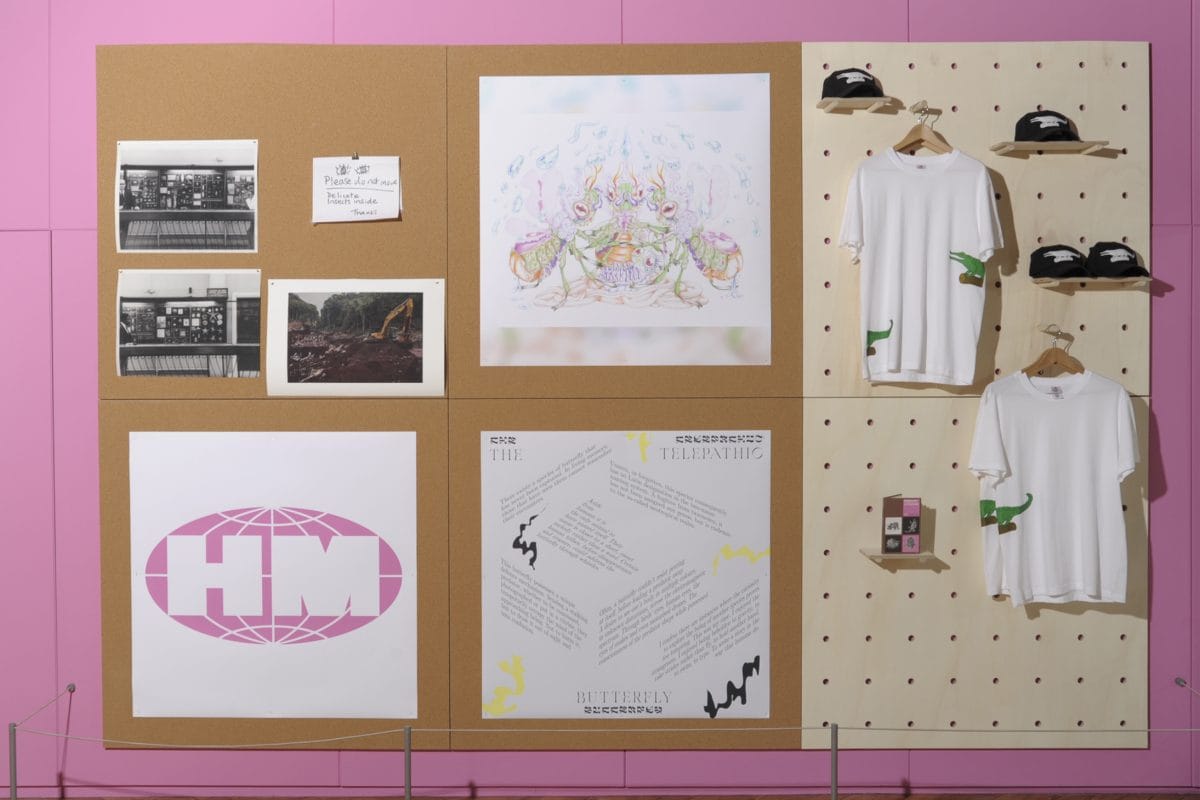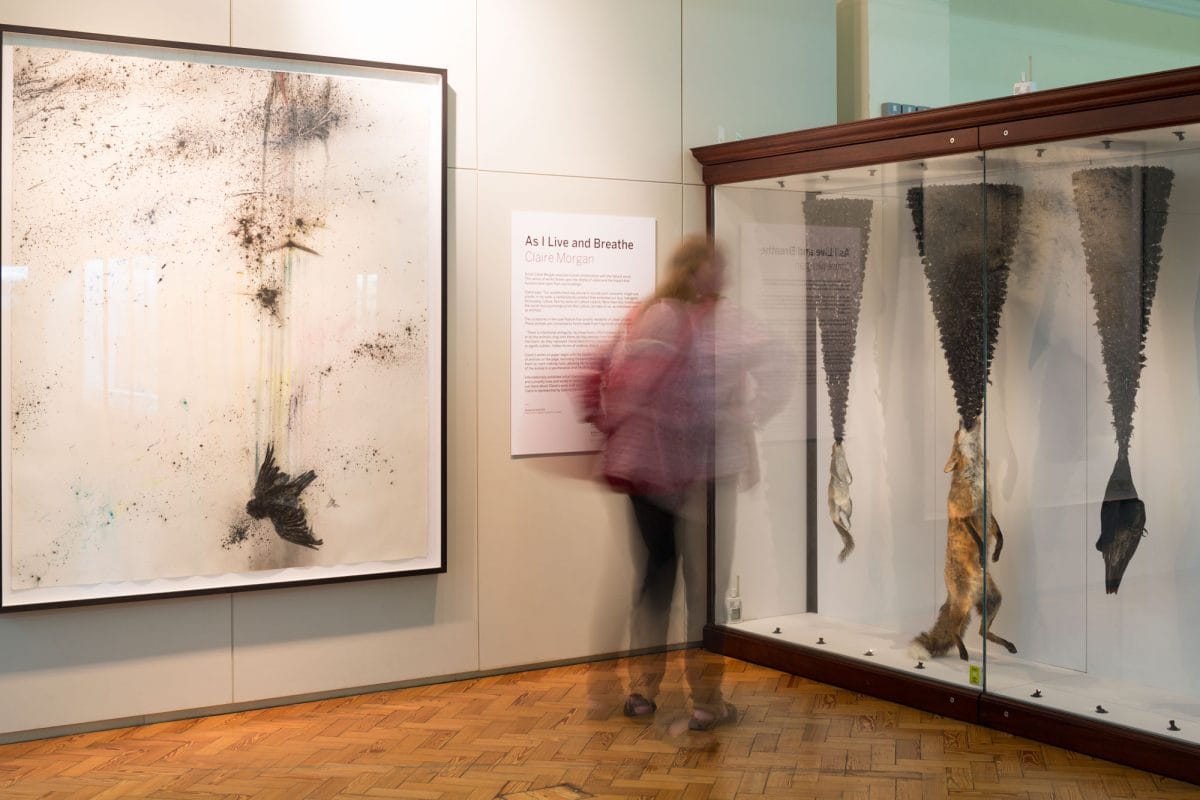Artists and academics research and develop new work in response to our collections of anthropology, natural history, musical instruments and the living collections.
Sometimes these works are displayed, published or performed at the Museum and Gardens.
You can find information about current opportunities, residencies and any future commission opportunities below.



Ivonne Charlotte Marais is undertaking a PhD research project at the Horniman to interrogate the lasting legacy of colonial violence in museum archives. The project is funded through the AHRC Techne Collaborative Doctoral award.
Her research focuses on the southern African material culture archives at the Horniman and trace how the knowledge extracted, or not as the case may be, during colonial occupation of certain objects is still infiltrating into museum displays. This research will contribute to the Horniman’s broader aims of decolonising museum practice and interrogating the museum’s colonial collections.
Marie Smith, a London-based neurodivergent visual artist, was digital artist in residence at the Horniman in 2023.
Marie’s six-month residency at the Horniman ran concurrently with another at the Museum of Art and Photography (MAP) in Bangalore, as part of a joint project. The joint residencies were in partnership with curator and expert in photography Zelda Cheatle
Marie researched and explored three elements – people, soil and trees – in the Horniman’s Nature Trail, Gardens and collections. She documented her residency and shared her experiences on her website, as well as in a digital exhibition hosted by the Horniman.
Artist Maia Conran is the Horniman Museum Arts Fellow. The Fellowship, in collaboration with University of the Arts London (UAL), will take place in dialogue with the 茶, चाय, Tea (Cha, Chai, Tea) Exhibition.
The project will use photography, film, installation and performance in ways that research tea as a cultural practice, drawing a connection between the advent of photography and the Horniman’s Tea business – both of which were founded or developed around 1826.
If tea marks a social time, photography is its equal for recording time spent together. Through practices of sharing and hospitality, this project proposes not ‘the story’ but ‘stories’ of tea as a social and collaborative process. The fellowship will draw out imperial and postcolonial relationships between photography, tea and time over the next three years.
The Fellowship will begin by inviting discussions and engaging with the Horniman’s collection. Maia Conran will convene a conference in 2024, inviting diverse, critical perspectives on tea, photography and time, hosted by both institutions.
About Maia
Maia Conran is an artist from North Wales and Course Leader of BA Fine Art Photography at Camberwell College of Arts, London.
Maia exhibits in collaborative and group exhibitions internationally. Her work has also been selected for international awards, film festivals and screenings, including at the BFI, London; Dynamo Arts, Vancouver; Danielle Arnaud, London; X Marks the Bokship, London; and Screengrab International Media Arts Award, Townsville. A single screen version of her multi-screen film Term is published on DVD by Filmarmalade, and her work is the subject of a monograph published by Grand Union Gallery, Birmingham.
Solo exhibitions include: Grand Union (Birmingham), G39 (Cardiff), IMT Gallery, Kingsgate Workshops (both London), Exeter Phoenix, Bristol Diving School (collaboratively as Conran and Haimes) and Skelf Project Space (online). Maia has been awarded residencies at Cardiff Contemporary Art Festival; Glyn Vivian Gallery Swansea, Standpoint Gallery, London, and the National Slate Museum of Wales. Conran is currently completing her PhD in film practice, at Queen Mary University of London.
Horniman Museum Art, Design and Natural History Fellowship
In 2017, Dr. Dan Byrne-Smith, Senior Lecturer in Fine Art Theory at Chelsea College of Arts, was welcomed as the Horniman Museum Art, Design and Natural History Fellow, in an exciting collaboration between the Horniman and Camberwell, Chelsea, Wimbledon Graduate School, University of the Arts London (UAL).
Over three years, Dan explored the Horniman’s acclaimed Natural History collection through the lens of science fiction, examining how audiences might engage with the collection to encourage and develop awareness around the environmental issues currently affecting the future of our planet.
A powerful force in popular culture, science fiction has the ability to engage and entertain and has a long history of imagining threats to the natural world, illuminating the dangers that will emerge in the future if not addressed in the here and now. Hollywood cinema offers bleak visions of environmental catastrophe, from 1970s films such as Silent Running and Soylent Green to the endless desert of 2015’s Mad Max: Fury Road. These films all hold the audiences of today accountable for the depicted futures.
Science fiction can also offer profoundly critical perspectives on relationships between humans and the natural world. These ideas can be traced back to the writings of Mary Shelley, Jules Verne, and H.G. Wells. Today, authors such as Margaret Atwood and Nnedi Okorafor continue to explore the boundaries between humans and other life in their speculative works.
The topics that Dan explored during his Fellowship include global climate change, the biodiversity crisis and species extinction, evolution and non-human networks. The Fellowship also offered ways to imagine diverse environments through science-fiction motifs and ideas and explore the challenges and risks they face.
Bringing together different facets of his research interests, Dan explored the balance between seriousness and entertainment that science fiction offers, starting new conversations about the role of the Horniman’s Natural History collection, looking at new forms of engagement between people and collections and ultimately how those engagements can make a difference.
Nathalie Cooper has joined the Horniman to complete a PhD research project interrogating the legacies of empire in the Horniman’s early institutional history. This project is in collaboration with the University of Warwick and generously funded by Midlands4Cities.
Over the next four years, Nathalie will investigate the provenance of the Horniman’s founding collections and its links to imperial violence, while also taking a critical look at the practices of collection, display and interpretation employed by the Museum during the late nineteenth and early twentieth century. She is particularly interested in the taxonomic operations of the Horniman and how this has shaped, and continues to shape, our engagement with material cultures.
The Horniman has partnered with Goldsmiths’ on the MA in Anthropology and Museum Practice.
The MA combines academic expertise with practical information from museum professionals across the spectrum of disciplines at the Museum.
Artist and writer Harun Morrison was appointed to the Decolonising Natural History residency in partnership with the Delfina Foundation, and the resulting display: Dolphin Head Mountain.
In 2006, alongside Helen Walker, Harun co-founded collective practice They Are Here. Recent commissions include I’ll Bring You Flowers (2019), Survival Kit 10, Riga, and Laughing Matter (2018) at Studio Voltaire co-commissioned by Block Universe, which saw the gallery converted into a comedy club. The performance 40 Temps, 8 Days (2017) at Tate Modern highlighted the use of temp labour at the institution in the context of the wider gig-economy.
Harun is a former artist-in-residence with Arts Catalyst, Furtherfield, IASPIS and Botyrka Konsthall. He has also been a visiting artist at various universities and is associate faculty for the studio program Conditions, in Croydon. In recent years Morrison has co-designed a number of community gardens, including the conversion of a car park in Dagenham, East London on the Beacontree Estate, and Bootle Library in Liverpool, commissioned by Rule of Threes.
His work has been shown at the Dakar Biennial, Senegal, and Eastside Projects in Birmingham. His forthcoming novel, The Escape Artist, will be published by Book Works in 2022. Since 2019, he has been a trustee of the Black Cultural Archive.
Artquest, in partnership with the Horniman, have been offering artistic opportunities since 2016.
Artist in residence have included Joshua Sofaer, Alex Julyan and Helena Hunter.
In 2019, Artquest’s Peer Forum at the Horniman was awarded to Borbála Soós who will be working with a group of artists around the theme of rewilding.
Music in the Making was the Horniman’s Arts Council England funded four-year programme to improve understanding of the Museum’s musical instrument collection and to maximise its potential through creative programming and performance. As part of the project, the Art Fund supported two one-day seminars, held online in January and March 2021. The reports below outline the proceedings of the two events.
Musical Instrument Collections Inspiring New Work: Compositions, Instruments and Performance
This seminar explored possibilities for instrument makers, musicians and composers to use musical instrument collections as the starting point for developing new work. The first of three panels included reports from museum curators and academics about making collections more accessible to wider audiences. The second was made up of presentations from participating artists about their recent museum-focussed projects. The final panel discussed the 696 Project, in which the Horniman invited pioneers of the British Black Music scene to engage with the museum’s collections.
Museums Supporting Young People’s Music Education
Musical collections have enormous potential for scholarship, community engagement and creative artistic practice. In this seminar, representatives from UK and international museums, as well as schools, universities and youth music providers discussed the role of musical collections in their learning and engagement projects. The aim was to explore current practices, share insights and experiences, and produce a set of practical approaches that could assist in implementing successful programmes and in developing new educational resources.